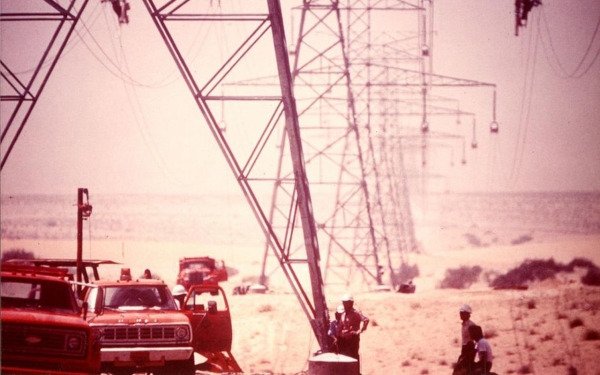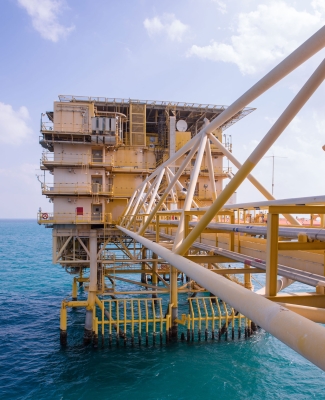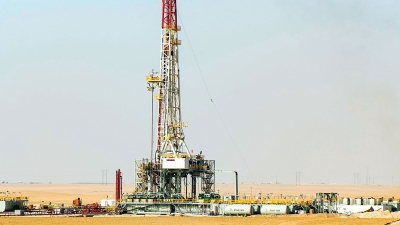

Electricity in the Kingdom of Saudi Arabia began in 1907 with two generators powered by coal and kerosene. Over the following decades, it evolved, leading the Kingdom into the era of renewable energy projects. The country witnessed the establishment of a legislative and regulatory framework for this sector, with specialized companies created to produce and transmit electricity.
The history of the introduction of electricity into Saudi Arabia
Electricity was introduced into the Kingdom in 1907 through the Prophet's Mosque, making it the first place to be lit with electricity. This was achieved using two generators, one powered by coal and the other by kerosene, with a production capacity of twenty KW. A charged battery was also available to light the mosque for al-Fajr prayer. This means there were less than thirty years between establishing the world's first power plant in 1889 and introducing electricity into the Kingdom's territories.
The Grand Mosque was the second location to witness the introduction of electricity into the Kingdom in 1918, using special generators belonging to the Administration of the Grand Mosque, located in the Ajyad area.
Makkah al-Mukarramah was also the first city in the Kingdom to have its streets and homes illuminated by electricity. The surplus electricity from the city's power plants was used to light the streets and neighborhoods and for ice factories and mechanized grain mills. These generators in al-Madinah al-Munawwarah, Makkah al-Mukarramah, and Jeddah represent the true beginning of electricity's presence in the Kingdom.
Power generation in Saudi Arabia
A government committee was formed to study electricity generation in the Kingdom, and in December 1930, it held a meeting in the presence of the then Viceroy of Hejaz, Prince Faisal Bin Abdulaziz Al Saud. The idea behind the project was that the state would cover two-thirds of the cost while the remaining third would be offered as shares to citizens, priced at GBP3 per share.
Following the experiment's initial success, the government expanded its efforts to other regions of the Kingdom. In 1932, the government enacted the Electricity Concession Law, which marked the official start of investments in the electricity sector. Businessmen responded positively to this initiative, leading the government to grant concessions in several cities. The first concession was awarded in Jeddah City to Muhammad Abdullah Ali Rida and Ibrahim Shakir, allowing them to supply electricity. In 1946, Ibrahim al-Jufali and his brothers received the same concession in Taif. The following year, in 1947, approval was granted to establish a joint-stock company in Jazan, which was authorized to provide electricity and water to the town. Additionally, during that year, the Shura Council approved the establishment of a joint-stock electricity company in al-Madinah al-Munawwarah, led by Abdulaziz al-Khuriji.
In 1948, the Founding King Abdulaziz Bin Abdulrahman Al Saud ordered the illumination of Riyadh with electricity. Within months, diesel-powered machines and generators arrived in Riyadh, forming the foundation of the capital's first power plant, which generated 1,600 KW. The following year, additional diesel-powered machines with 1,140 hp were added, connected to an alternating current generator, to light homes and streets.
In the Eastern Province, the Electric Power Company for Dhahran was established in 1950. It was responsible for generating and distributing electricity to Dhahran, Dammam, and Khobar. Additionally, Saudi Aramco generated electricity for its operations.
The Ministry of Energy and Electricity in Saudi Arabia
The Ministry of Energy oversees the various activities and operations of the Kingdom's energy sectors through a strategic plan that includes the electricity and renewable energy sectors, such as complementary energy and thermal materials.
The Ministry of Energy implements programs to achieve its goals, embracing innovation, technology, and artificial intelligence concepts in the energy sector. These include the Oil Sustainability Program, which features plans for the Kingdom to become the world's largest exporter of clean hydrogen. This encompasses blue hydrogen from hydrocarbon sources and green hydrogen from renewable sources. Other initiatives include the Optimum Energy Mix Program, energy efficiency programs, and efforts to empower the local manufacturing of solar and wind energy components.
Establishment of the Saudi Electricity Company
Following the expansion of electricity usage, the urgent need to regulate the sector, and the dawn of the third millennium, the Saudi Electricity Company was established on April 5, 2000, after a decision by the Council of Ministers was issued on November 30, 1998, to restructure the electricity sector. This was achieved by merging all the unified Saudi electricity companies in the central, eastern, western, and southern regions, along with the ten companies operating in the northern part of the Kingdom and the operational electricity projects run by the General Electricity Corporation, into a single joint-stock company named Saudi Electricity Company.
Electricity production in the Kingdom jumped from twenty KW in 1907, the first electricity produced in the Kingdom, to around 290.000.000.00 KW, which the Saudi Electricity Company sold in 2018. The company also succeeded in providing electricity to 13,112 cities, villages, and hamlets spread across the Kingdom's vast area.
Organizational structure of Saudi Electricity Company
In 2002, the Board of Directors of Saudi Electricity Company approved a new phased organizational structure designed based on specialized activities, which include strategic work units: generation, transmission, distribution, and shared activities and support services. This restructuring aimed to enhance performance across all activities and to define future directions for comprehensive change.
The generation operations activity focuses on shaping a new future for energy in the Kingdom, especially in terms of power production and improving the efficiency of energy production from the Saudi Electricity Company's power plants in various regions. Additionally, it seeks to reduce pollution levels, keeping them within globally permissible indices and limits.
The Saudi Electricity Company's generation operations have faced several challenges but have also achieved numerous milestones, enhancing the capacity of power plants across the Kingdom and ensuring a steady energy supply.
Dawiyat Integrated Telecommunications and Information Technology Company
Dawiyat Integrated Telecommunications and Information Technology Company was established in 2009 and is wholly owned by Saudi Electricity Company. It aims to invest the company’s resources in the widespread fiber optics network that covers more than eighty thousand km across the Kingdom, including villages, hamlets, and border areas.
Dawiyat Integrated Telecommunications and Information Technology Company has the national and international connectivity infrastructure. Its fiber optic network covers all provinces and cities in the Kingdom and extends to border points. It is also connected to the Gulf Cooperation Council countries with a network exceeding eighty thousand km, growing at a rate of 5 percent annually. Dawiyat Integrated Telecommunications and Information Technology Company's fiber optic networks are independent, highly reliable, and provide continuous service.
National Grid SA
National Grid SA was established in 2012 as a limited liability company wholly owned by Saudi Electricity Company. It began its operations by overseeing the electrical system and monitoring the loads around the clock, improving the efficiency of the electrical system through the economic operation of power stations connected to the electrical grid. The company also focuses on maintaining the electrical network to ensure the stable and reliable transmission of electrical energy to load centers across the Kingdom. It enhances the electrical grid with substations and high-voltage connection lines of 110-132 kV and improves the capacity of wired and wireless communication networks through multiple phases. This includes ensuring the continuous development of programs and operations across various fields and planning, design, and implementation processes.
The distribution and customer services activity is responsible for receiving electricity from the transmission networks, distributing it, and providing customers with reliable and secure electricity services. The company works to improve service quality, issue and distribute electricity consumption bills, and implement its annual plans and programs.
The electricity transmission activity includes several goals, priorities, and performance standards, such as the continuous improvement of distribution networks to ensure they operate at the desired level, increasing the rate of electricity service delivery to new customers in cities, villages, and population centers, developing customer service centers, applying modern technologies, enhancing energy efficiency, simplifying procedures for connecting electricity services, improving the performance of frontline staff, and developing skills in calculating consumption and reading bills.
Saudi Electricity Project Development Company
The Saudi Electricity Project Development Company was established in 2015 as a limited liability company wholly owned by Saudi Electricity Company. It is responsible for purchasing materials and equipment, executing energy projects, managing construction projects, and carrying out detailed engineering designs. The company aims to enhance the quality of services for internal and external clients by providing outstanding engineering services and managing diverse projects. It also focuses on empowering national human resources by building their capabilities, with a commitment to environmental safety and maintaining the highest quality standards.
The strategy of Saudi Electricity Project Development Company is to become the preferred choice for Saudi Electricity Company and its clients by diversifying its services across multiple geographic regions, leveraging its varied capabilities and brand recognition.
Saudi Power Production Company
The Saudi Power Production Company, established in 2020, is wholly owned by the Saudi Electricity Company. It is responsible for producing electrical energy and ensuring the stability of the electrical system through thirty-eight power generation stations spread across the Kingdom's provinces.
Renewable energy in Saudi Arabia
In the third millennium, the Kingdom began implementing renewable energy projects to increase the contribution of these energy sources to domestic consumption, reduce carbon emissions, and support the Saudi Green Initiative. Among these projects are the Sudair Solar PV IPP in Sudair Industrial City, Dawmat al-Jandal Wind Farm in al-Jawf Province, ar-Rass 1 Solar PV Park Project, Wadi ad-Dawasir Solar PV Park Project, Layla Solar PV Project, al-Kahfah Solar PV Park Project, ar-Rass 2 Solar PV Park Project, Saad 1 Solar Power Station, Saad 2 Solar Power Station, Sikaka Solar PV Project, Shuaibah 1 and Shuaibah 2 Solar PV Project, Rabigh Solar PV Project, and Jeddah Solar PV Project.
Saudi Electricity Regulatory Authority
The Saudi Electricity Regulatory Authority was established by a decision from the Council of Ministers on November 12, 2001. It is a regulatory body responsible for overseeing the electricity sector, including electricity generation, combined production from multiple energy sources, electricity transmission, distribution, trading, retail sales, the role of the main buyer, and province cooling.
Previously known as the 'Water and Electricity Regulatory Authority,' the Council of Ministers approved the transformation of the Saline Water Conversion Corporation into an entity named 'The Saudi Water Authority' in 2024. As a result, the Saudi Electricity Regulatory Authority now focuses solely on regulating electricity services.
The authority's strategy includes several key objectives aimed at improving its regulated activities and enhancing its role in consumer protection through clear and transparent regulatory frameworks that create a favorable environment for investors. The regulations specify that the authority should oversee and monitor services, coordinate between relevant institutions, entities, and licensed individuals, and establish the necessary regulatory and procedural frameworks to ensure that services are provided at high quality and reliability levels at competitive and fair consumer prices.
The strategic goals of the Saudi Electricity Regulatory Authority include customer centrality, ensuring it serves as a model for customer-centricity in its operations; consumer protection and empowerment; safeguarding the public interest and the rights of all stakeholders; reliability by ensuring continuous and flexible electricity supply; service effectiveness through improving service quality, reducing costs, and encouraging operational improvements; market development and support, increasing investment opportunities, aligning with the ministerial committee's restructuring agenda and Saudi Electricity Company's strategies; sustainability by improving sector efficiency and achieving sustainability in economic, environmental, and energy supply aspects.
The Saudi Electricity Regulatory Authority offers several services, including the Consumption Footprint, which allows consumers to track and compare their daily energy consumption with different rate tiers and identify consumption patterns. It also provides a complaint submission service, enabling consumers to lodge complaints if a service provider closes a complaint without resolution. Other offerings include Key Performance Indicators (KPIs) based on global best practices in the electricity sector and Shamsi Gate, an online tool to assess the economic feasibility of installing solar energy systems.
Electricity Law in Saudi Arabia
The Council of Ministers issued the Electricity Law on December 29, 2020. This law consists of twenty-three articles designed to foster fair competition within electricity activities, enhance the quality of electricity services provided to consumers, and protect consumer rights. These rights include access to reliable and efficient electricity services and the ability to choose from licensed electricity providers offering competitive and reasonable prices, ensuring fairness among consumers. It also streamlines consumers' access to electricity, extends electricity services to previously unserved areas, and ensures the electricity sector aligns with state policies and directives. This includes safeguarding the rights and interests of licensees, establishing a clear and stable regulatory framework for both public and private sector activities, and guaranteeing safe, reliable, and highly efficient electricity supplies at the lowest possible cost. Additionally, efforts focus on developing the electricity sector's structure in the Kingdom through fair and effective processes that promote competition within electricity-related activities. The law encourages private sector participation in the systematic expansion of electricity services, allowing for fair economic returns based on commercial principles. It also mandates compliance with environmental regulations, safety standards, and established benchmarks within the electricity sector. Additionally, the law promotes research and development and the localization of technology, jobs, and services within this industry.
The Electricity Law outlines the roles and responsibilities of the Ministry of Energy and the Saudi Electricity Regulatory Authority. It also establishes the regulatory framework for licenses issued by the Saudi Electricity Regulatory Authority for conducting electrical operations. The law reviews backup energy sources, pricing, tariffs, competition, the development of electricity activity structure, violations and penalties, and dispute resolution.
Related quizzes

